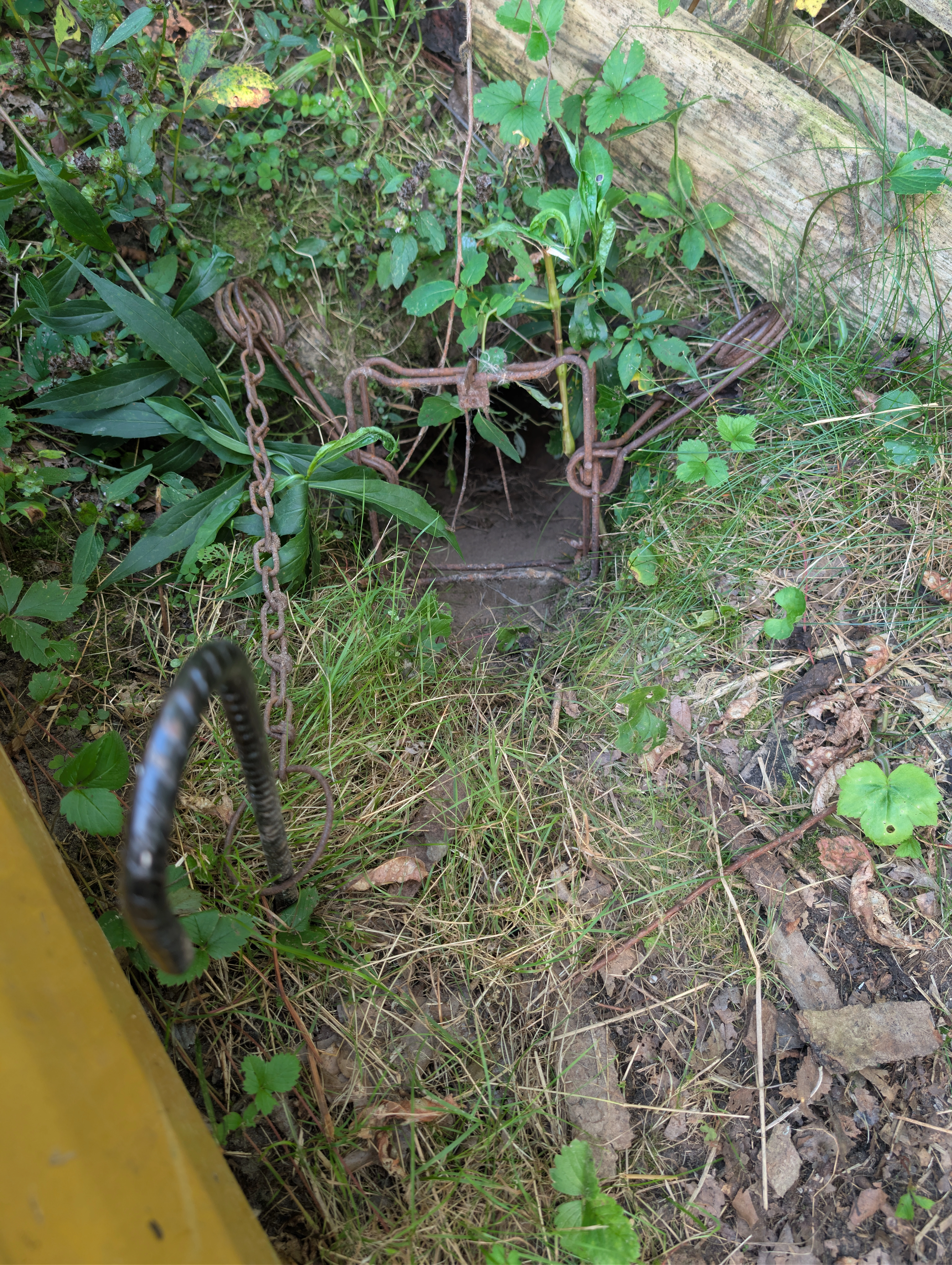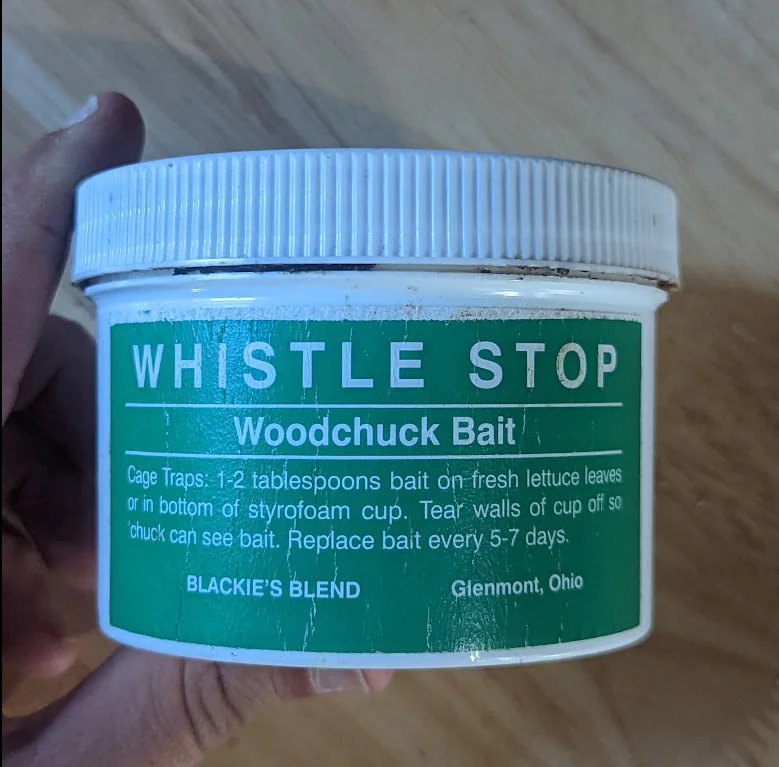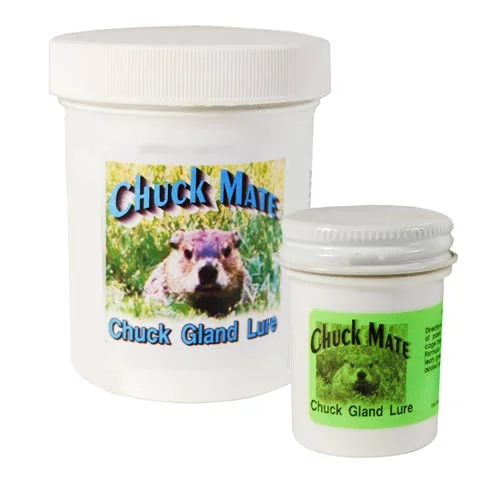groundhog management and control
on this page
 #220 Duke Double Spring Body Grip Trap positioned at burrow entrance - an effective lethal control method
#220 Duke Double Spring Body Grip Trap positioned at burrow entrance - an effective lethal control method
management decision framework
as i mentioned at the beginning, no matter what the softies tell you, there is no way to manage groundhog populations without intervention. lotka-volterra dynamics combined with litters of six chucklings per year mean you have no chance of success without hunting or trapping. luckily, while a frustratingly perceptive creature in the open, you can easily trap them or hunt them with the right setup.
selecting appropriate control methods depends on situation-specific factors:
attraction principles
food-based baiting
effective baits ranked by attraction power:1
| bait type | effectiveness | placement strategy | notes |
|---|---|---|---|
| cantaloupe | highest | back of trap, past trigger | strong sweet scent |
| apples (fresh sliced) | very high | multiple pieces | aromatic varieties best |
| garden vegetables (current diet) | very high | match what they’re eating | highest success rate |
| carrots, lettuce | high | combine multiple types | fresh, not wilted |
| commercial lures | moderate | apply to fruit/vegetable | ”greasy, flowery smell”2 |
| peanut butter | moderate | on apple slice | backup option |
a number of these baits will also draw other animals, such as squirrels, raccoons, or your own chickens,ducks, or goats. you should adapt your bait selection and placement to the specific time and place, of course.
if you want an easy solution that lasts longer, i swear by a woodchuck bait called whistle stop. dip a twig in, brush it against some flowering clover, and then set up with your 22 or set the clover in a trap.
 whistle stop by blackie’s blend - the best woodchuck bait i’ve found
whistle stop by blackie’s blend - the best woodchuck bait i’ve found
bait placement technique
proper bait positioning ensures trap triggering:3
force complete entry by placing bait beyond trigger mechanism. thankfully, unlike raccoons, groundhogs are neither clever nor endowed with useful hands, so they’re much more likely to trigger the trap. only very young groundhogs are likely to cause frustration.
deterrent strategies
chemical deterrents
as i noted above, drawing predators to your garden or foodplot has consequences, and i personally try to avoid bringing foxes or coyotes any closer to my chickens or goats than i need to. that said, predator urine effectiveness is quite high as demonstrated in 4.
| deterrent | application method | effectiveness | duration |
|---|---|---|---|
| bobcat urine | topical spray on plants | 98% reduction in gnawing | 2-4 weeks |
| coyote/fox urine | perimeter application | high for area denial | 1-3 weeks |
| used cat litter | around burrow entrances | moderate | 3-7 days |
| ammonia soaked rags | in burrow entrances | temporary | 2-3 days |
understanding scent signals
groundhog scent marking is territorial warning, not attraction:5. remember - if you plan to eat them, these pheromones do not taste good and you will need to remove their glands before cooking.
i have never personally used gland extract, but jameson’s does sell a brilliantly-named “chuck mate” product.
 “chuck mate” by jameson’s - groundhog gland lure with a perfect name
“chuck mate” by jameson’s - groundhog gland lure with a perfect name
trapping methods
trap selection guide
| trap type | size | best use | legal considerations |
|---|---|---|---|
| live cage trap | 30-36” x 10-12” | residential, relocation | check daily required6 |
| conibear/body-grip trap | #160-220 | burrow sets | set carefully |
| snares | many entrances/exits | set carefully |
live trapping technique
optimal trap placement and preparation:1
- location: 3-5 feet from main burrow entrance or near food plot/garden
- orientation: along established travel path
- stabilization: level ground, prevent wobbling
- camouflage: cover wire floor with dirt, add leaves and grass around sides and entrance
trap timing effectiveness
| season | success rate | best time of day | notes |
|---|---|---|---|
| spring (apr-may) | high | early morning | hungry after hibernation |
| summer (jun-aug) | moderate | dawn/dusk | avoid midday heat |
| fall (sep-oct) | highest | all day | hyperphagia feeding |
| winter | not applicable | - | hibernating |
hunting
hunting groundhogs is notorously difficult due to their burrowing habits, keen situation awareness, and hilarious sprinting and climbing abilities. however, over time, i’ve found that there are some tricks to making things easier.
-
if you have a trail cam or other networked camera, use it to your advantage. having the intitiative to surprise the groundhog makes your job much easier than happening upon one.
-
if you mow an area near a burrow, leave one patch of clover uncut. this will create a highly attractive spot where the groundhog has no concealment, making it easy for you to spot them and hard for them to hide.
-
if you have bruised or damaged fruit that hasn’t yet molded, use it to draw them to a location with a clear shot. spread the bait out in a circle or arc away from your shooting position, which will cause them to turn their back away from you as they track the food.
-
of course, baits like whistle stop make a great option. turn the container upside down, rub it on the clover flowers, and then get to your shooting position.
-
if you are shooting further out for your caliber and weapon, wait until they stand up to take the shot. if you don’t plan to eat this one, their vertical position will give you a better chance even with variable drop on 17hmr or 22lr.
-
if you are shooting in wind, your left-right alignment probably matters more than vertical. depending on your relative height, don’t take the shot when they’re standing as the closer the bullet is to the ground, the less the wind will affect it.
-
if the groundhog is near a tree, you might try treeing it yourself first on foot or with a warning shot. they can climb up quickly, but they are not agile getting back down.
exclusion fencing
i’m including this for completeness, but unless you like wasting time and money, buy a 10/22 with the same money instead.
design specifications
effective groundhog fence requirements:7
installation steps
- excavation: dig 12-inch deep trench around perimeter
- l-footer creation: bend bottom 12 inches outward at 90°
- installation: place fence with l-footer extending away from protected area
- backfill: cover l-footer with soil
- top treatment: leave top 12-15 inches unattached or bent outward
cost analysis
| area size | material cost | labor (diy) | professional install | annual roi |
|---|---|---|---|---|
| garden (500 sq ft) | $200-400 | 8-12 hours | $800-1200 | $200-500 |
| 1/4 acre | $800-1200 | 20-30 hours | $2500-3500 | $400-1000 |
| 1 acre | $2500-4000 | 60-80 hours | $8000-12000 | $1000-3000 |
lethal control methods
hunting considerations in michigan
michigan wildlife conservation order section 3.506 states:8
3.506 Woodchucks, open season, exception. Sec. 3.506 (1) The open season for taking woodchucks by hunting shall be statewide all year except for state park and recreation areas which shall be closed April 1 to September 14. History: Eff. Mar 31, 1989; Am. 20, 1989, Eff. Sep 1, 1989; Am. 3, 2015, Eff. May 8, 2015; Am. 6, 2023; Eff. May 11, 2023.
| aspect | michigan regulation |
|---|---|
| legal citation | wildlife conservation order section 3.506 |
| season | year-round statewide (closed apr 1 - sept 14 in state parks/recreation areas) |
| license required | valid base license for hunting |
| property damage | no license needed on private property when doing or about to cause damage |
| damage defined | physical harm to forest products, roads, dams, buildings, orchards, apiaries, livestock, crops |
| methods allowed | all legal hunting and trapping methods permitted by law |
fumigation
i personally don’t recommend fumigation for any purpose, but including the research below for those who might. gas cartridge application is prescribed in some agricultural settings:9
safety requirements:
- minimum 50 feet from structures
- no use near flammable materials
- seal all burrow entrances immediately
- never use under buildings
effectiveness: 70-90% when properly applied
legal and ethical considerations
michigan regulatory framework
critical michigan legal requirements:6
- year-round control: allowed with valid base license (Wildlife Conservation Order 3.506)
- property damage exception: no license needed on private property when doing or physically present where they could imminently cause damage
- damage definition: physical harm to forest products, roads, dams, buildings, orchards, apiaries, livestock and horticultural or agricultural crops
- trap checking: must check every 24 hours per michigan law
- trap identification: name and address required on all traps
- no relocation: must release on same property or euthanize - relocation to other properties prohibited
- discharge ordinances: check local ordinances for firearm restrictions
relocation prohibited in michigan
michigan law prohibits groundhog relocation:
- illegal to relocate: groundhogs cannot be moved to another property per michigan dnr6
- options: release on same property or humanely euthanize only
- rabies vector concerns: groundhogs can carry rabies
- high mortality: relocated animals suffer 70%+ mortality rates
- homing behavior: groundhogs can travel up to 5 miles to return
historical control methods
evolution of management techniques:11
traditional methods (1800s-early 1900s)
- steel jaw traps at burrow entrances
- smoking out with sulfur
- flooding burrows
- bounty systems
modern improvements
- humane trap designs
- targeted deterrents based on behavior research
- integrated pest management approach
- recognition of ecological role
references
[1] Trapping Guide Groundhogs. Havahart Wildlife Control.
[2] Pro-Pest Woodchuck/Groundhog Lure. Animal Traps & Supplies.
[3] Hygnstrom, S.E., Timm, R.M., & Larson, G.E. (1994). Prevention and Control of Wildlife Damage. Lincoln, NE: University of Nebraska Cooperative Extension.
[5] Woodchuck Scent Marking. Winterberry Wildlife.
[9] Managing Woodchuck Problems in Missouri. MU Extension.
[10] Michigan United Conservation Clubs. (2023). Wildlife Management Resources. Lansing, MI: MUCC.
[11] Newhouse, S. (1887). The Trapper’s Guide. Wallingford, CT: Oneida Community.